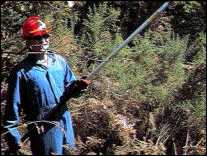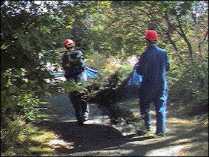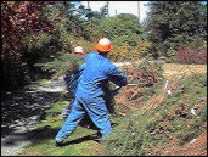|
| Introduction
The Veins of Life Watershed society,
in association with the Saanich
Parks Department, undertook the eradication of Gorse from
the Gorge Park. The Veins of Life worked from August to
October 2000, removing all Gorse from the park, most notably
along the banks of the Gorge where the plant was most extensive.
Gorse is an extremely tough, spiked bush, rivalling blackberry
bushes in its ability to injure would-be attackers.
Botany
Gorse is an exotic, invasive species also known as Furze.
It is a thorny shrub growing up to eight feet tall and is
found on heaths, in moors and pastures, and upon open woodlands,
blooming with a bright yellow flower in spring through to
early autumn. Gorse is native to the Mediterranean and
is a serious weed in Australia, New Zealand, and both the
east and west coasts of North America. It is and extremely
strong competitor in well-drained areas where the soil has
been disturbed. Furthermore, due to the fact that it
is not a species native to Vancouver Island, it easily out-competes
local plants, reducing their habitat. |
|
Equipment
- Loppers, Tarps
- Pole Saws (pictured, left), hand saws
- Large and Small Root Pullers
- Protective Equipment - punture-proof gloves, coveralls,
safety glasses, steel-toed boots, first-aid kit
|
|

|
| Methodology The
Gorge Park Gorse eradication project involved a four-stage process.
Gorse was cut down by hand, collected, hauled out, and the roots
were pulled.
The shrubs were cut at the base
of the plant leaving enough of the stem exposed to facilitate
later root removal. The gorse cutting were loaded onto
tarps and collected at a central point. Tarps were used
in order to reduce the potential for seed dispersal. Gorse
seeds can lay dormant for up to thirty years; thus, it was essential
to prevent the seeds from scattering.
In areas upon the banks of the Gorge,
root structures were not removed because doing so would decrease
the stabilization of the banks. Once all of the gorse
cuttings had been collected, Saanich parks removed and disposed
of the foul weed. |
| |
 |
 |
(From Left to Right) John and Kali remove Gorse using pole saws
and root pullers, remove the biomass on a tarp to ensure the seeds
do not spread, and finally dispose of the plant material on manicured
grass to await pickup.
| Results and Accomplishments Phase II of the program
involved the planting of new native species in the areas lef
vacant by the expanses of Gorse. Landscape fabric and
leaf mulch were used as deterants for sprouts from missed roots
or new growth. Over 50 new native shrubs and trees were
planted in the vacated areas. This included Shore pine,
Snowberry,
Ocean
Spray, Douglas
fir, Dull
Oregon grape, and alder.
Monitoring 6 monts after the planting show that this method
has been successful ths far. The plants appear to be healthy
and there are limited numbers of shoots appearing through the
landscape fabric. |
| Conclusions It was found that personal protective
equipment, especially puncture-proof gloves, was absolutely
essential in dealing with Gorse. Also, pole saws were
extremely advantageous for reaching stands of gorse upon steep
banks. Furthermore, it should be noted that cutting down
the Gorse is only the first-step in eradication. Follow-up
treatments are essential to prevent re-growth. The Veins
of Life Watershed Society is working with Saanich Parks to control
re-growth by mulching the area now cleared of Gorse. Planting
of native species is then the next step, and a continued maintenance
program that checks the regrowth of Gorse and the potential
growth of other pioneer species such as Himalayan blackberry
or Scotch broom do not take advantage of the open space. |
| |
Gorse biomass collects quickly along
Gorge Park.The process of its eradication in the park requires commitment
over years to ensure that it will not return.
Email:
volws@salishsea.ca
©
2009 Veins of Life Watershed Society / All Rights Reserved / if you
wish to use any info for commercial or non commercial usage you must
obtain permissions from The Veins of Life Watershed Society
|